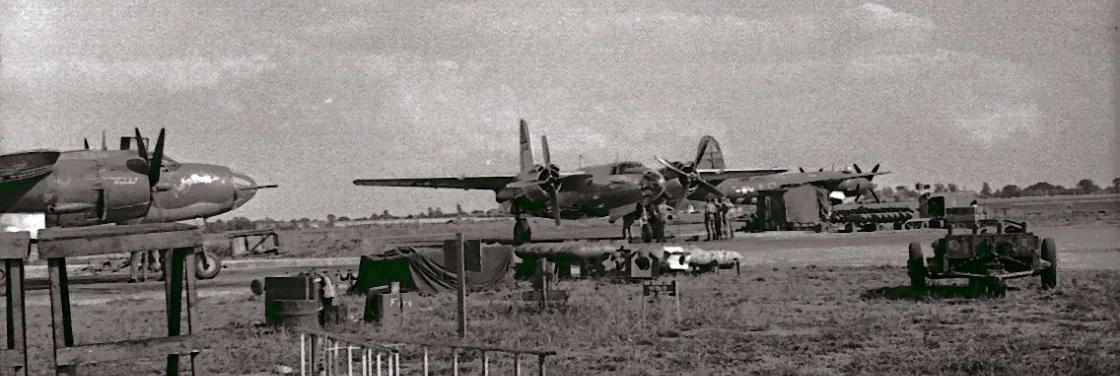
USAAF Matching Green - The Human Element
B-26 Martin Marauders of the 391st Bomb Group (Medium) on their hardstands at Matching airfield.
Photo courtesy of Dane Donato.
Tech Sergeant Ralph Hobbs-391st Bomb Group.
Ryan
Hobb's
Grandfather
was
a
Tech
Sergeant,
and
flew
with
the
391st
BG
(M),
as
a
Flight
Engineer/Gunner,
until
late
Spring, 1944.
He then served as a Crew Chief when, finally, there were enough Flight Engineers available to crew the aircraft.
Below
is
a
series
of
Photographs
taken
at
Matching,
while
he
was
stationed
there
during
the
Second
World
War.60
years
on.
Martin Marauder B-26 "Ladybelle" on its hardstand, at Matching, with Ralph Hobbs. Note the "T2" type aircraft hangar that appears under construction
in the background. This is the No 2 Hangar that was on the South Eastern side of the airfield near Stock Hall and was never actually finished.
Ryan Hobbs is Ralphs Grandson. He visited Matching airfield in 2004 and is pictured standing, more or less on the same spot
as Ralph was albeit sixty years on.
Ralph Hobbs (third from left -back row) with other crew chiefs in front of the crew chiefs hut on Matching. These huts were made from discarded bomb
packing cases (see the door!) and provided welcome shelter whilst out on the airfields dispersals.
'Mission 47" By Wally Humphrey, 391st BG
The
pre-dinner
crowd
at
the
Officers
Club
was
going
through
its
daily
routine
of
getting
a
few
drinks
put
away
before
undertaking
the
usual
monotonous
army
mess;
I
say
monotonous
because
although
the
menu
may
vary,
eating
army
chow
is
a
habit
and
not
a
pleasure.There
was
the
usual
line
at
the
bar,
the
Ping-pong
tables
were
in
full
play,
someone
was
banging
out
a
tune
on
the
piano
in
competition
with
the
radio
and
about
various
tables
were
gathered
the
different
Squadrons
of
the
Group;
just
talking
shop
or
deep
in
idle
gossip,
with
an
array
of
half-filled
beer
bottles
and
glasses
in
hand
or
on
the
table.
At
precisely
five
minutes
to
six,
just
five
minutes
before
the
mess
hall
would
open,
the
telephone
rang,
the
bartender
answered
and
called
for
Capt.
Cunningham,
one
of
the
Group
intelligence
Officers;
seconds
later
he
called
for
attention
and
announced
that
all
alerted
crews
were
to
report
to
briefing
room
immediately,
without
eating.Well,
like
the
Armys
universal
"hurry
up
and
wait,"
it
was
after
1900
before
briefing started, and quite naturally everyone did his share of bitching at the ways of the Group and Bomber Command.
Our
target
was
behind
the
enemy
lines
at
a
troop
concentration
point,
and
the
route
in
and
out
was
shown
on
the
Velopticon,
which
projects
pictures
and
maps
on
a
screen;
soft
whistles
and
moans
came
from
crew
members,
it
definitely
was
a
hot
spot.
Engines
would
be
starting
at
2021,
the
second
box
off
first,
join
up
would
be
over
the
field
at
2055,
with
all
planes
in
formation
and
climbing
on
course.
Briefing
over,
everyone
gathered
his
parachute,
"Mae
West",
steel
helmet,
spare
chunks
of
armor
plate,
and
headed
out
for
the
six-by-six
trucks
that
distribute
the
crews
to
the
various
hardstands.
We
were
scheduled
to
fly
"Pinks
Lady"
out
on
her
81st
Combat
mission
without
an
abortion;
seems
our
ship
had
developed
mag
drop
and
needed
a
new
set
of
plugs
in
the
engine.
A
tribute
here
to
the
ground
crews
is
justified,
for
during
our
five
months
of
overseas
operation
we
have
had
only
two
single-engine
take-offs;
both
of
resulted
in
crash
landings.
But
here
too
the
B-26
comes
in
for
its
share
of
glory,
for
in
none
of
the
crash
landings
so
far
have
we
lost
a
single
crew
member;
some
have
been
injured
true,
but
they
all
have
managed
to
live
for
another
day.
2021,
and
engines
come
to
life
all
over
the
field,
to
be
warmed
up
and
flight
checked.
Ten
minutes
later
they
taxi
out,
each
one
falling
into
his
place
on
the
perimeter,
till
they
are
lined
up
one
being
behind
the
other
on
both
sides
of
runway
21
(210
degree
takeoff);
there
they
sway
softly
on
tricycle
landing
gears,
not
unlike
some
animated creation of man eager to spring into life and the calling vastness of the sky above.
At
2036
the
lead
ships
engines
roar
and
the
plane
leaps
forward,
gathering
speed
with
every
passing
yard
of
the
runway.
About
300
yards
go
by
before
the
pilot
pulls
the
nose
wheel
off
at
90
or
more
miles
per
hour,
slowly
the
airs
speed
indicator
climbs
towards
150,
the
plane
becomes
airborne;
seconds
later
the
end
of
the
runway
flashes
by
and
four
feet
in
the
air
the
copilot
lifts
the
wheels
and
divides
his
attention
between
the
flight
instruments and the view on his side of the cockpit.
However,
England
is
showing
some
of
its
best
weather
and
visibility
is
unlimited
in
all
directions,
although
some
clouds
are
building
in
the
West
and
to
the
South,
well,
that
would
be
right
for
the
weather
man
had
briefed
us
for
clouds
over
the
channel
and
from
.4
to
.6
tenth
Cumulus
over
the
target
with
bases
at
4,000
and
tops
at
9,000.Westward
we
climb
on
course,
directly
into
the
setting
sun.
Jeff
had
borrowed
my
sun
glasses
in
anticipation
of
its
glare;
you
see,
the
copilot
is
a
sort
of
second
brain
trust,
his
glasses
and
cigarettes
must
always
be
on
hand
and
never,
never
must
he
forget
matches or a lighter.
The
formation
comes
within
view
of
the
moors
and
hills
of
South
Central
England,
then
swings
southward
still
climbing
in
a
slow
easy
angle
or
rate
of
climb;
too
rapid
a
rate
will
cause
the
slower
ships
to
pull
high
manifold
pressure
and
r.p.m.,
thereby
burning
a
terrific
amount
of
gas.
Some
8,000
below
the
English
coast
passes
underneath,
clouds
have
now
built
up
and
the
outside
temperature
is
zero
degrees
Centigrade;
so
that
we
dodge
and
weave about them as much as possible, still we collect some ice, and the pitot-heaters have to be turned on.
Out
over
mid-channel
the
weather
truly
dominates
the
scene,
showers
are
over
on
the
left
of
us,
and
no
less
than
three
separate
layers
of
clouds
fill
the
sky;
some
being
flat
rain-filled
Nimbo-Cumulus
and
others
towering
snow-white
Cumulus,
that
catch
the
rays
of
the
setting
sun
in
breathless
beauty.
Then
true
to
Lt.
Henrys
prediction
the
clouds
began
to
break
out
of
their
solid
effect
and
between
the
openings
we
catch
glimpses
of
the
murky
Seine
Bay
and
the
distant
coast
of
the
Cherbourg
Peninsula;
darkness
is
setting
in
pretty
fast
now
and
the
closer
we
approach
land
the
clearer
becomes the details of battle.
A
dull
red
flash
leaps
from
one
of
the
hundreds
of
plots
on
the
bay
below,
then
a
similar
flash
from
a
companion
ship.
Hell,
it
must
be
warships
or
cruisers
giving
their
supporting
fire
to
the
armies
on
land;
sure
enough,
see
those
clustered
pin-point
flashes
inland,
just
like
the
winking
of
distant
stars.
Look
at
the
cloud
of
flak
over
Caen
and
St.
Lo,
hundreds
of
bursts
and
just
dark
enough
to
see
their
orange
bursts;
those
Lancasters
and
Halifaxes
that
were
ahead
of
us
coming
across
the
channel
must
be
catching
it,
gad,
I
hope
the
dive
bombers
and
fighters
are
spoiling
the
tracking
of
those
Jerry
Ack-Ack
gunners.
Weve
lost
track
of
the
first
box
coming
through
the
cloudy
channel,
and
our
box
does
a
360-degree
turn
to
gain
more
altitude
and
make
landfall
at
the
correct
place.
Damn,
its
dark,
how
in
the
world
are
we
going
to
find
our
target
in
this
mess?
Now
we
can
see
the
irregular line of artillery fire, coming from both sides at that, sure am glad Im in the Air Corps. Oh! Oh! Look at the flak low and to our right.
Guess
they
are
trying
to
scare
us
away
from
some
vital
target;
no,
they
are
shooting
at
a
box
of
Marauders
lower
than
us
and
heading
towards
the
channel
and
safety.
They
sweep
under
us
at
a
terrific
speed.
Look
at
the
concentrated
pattern
of
their
bursting
bombs
just
made;
something
down
there
no
longer
exists.
"Bomb-bays
open"
comes
over
the
interphone.
Must
be
we
are
hitting
a
target
of
opportunity
due
to
darkness
spoiling
visibility
over
the
primary.
"Bombs
away,
bomb-bays
closed"
and
we
bank
off
the
target
in
a
steep
turn
and
take
evasive
action
clear
to
the
coast.
Well,
that
was
an
easy
one,
very
little
flak
and
we
dropped
on
the
first
run;
and
with
good
results.
We
plow
back
towards
our
base
letting
down
gradually
all
the
way. The B-26 can really travel with the nose slightly down and bombs away.
Twilight
has
given
way
to
almost
complete
darkness
and
at
mid-channel
we
turn
on
our
navigational
lights,
feeling
certain
that
we
are
safe
from
enemy
fighters.
Back
over
the
field
we
peel
off
by
flights
and
land,
each
ship
coming
in
at
about
20
second
intervals,
the
same
as
for
takeoff.
Safely
down
we
taxi
to
our
hardstands,
where
the
crew
chiefs
hand-signal
us
to
our
parking
position,
then
we
unload
and
wait
for
the
trucks
to
carry
us
into
the
crew
room
for
debriefing;
meanwhile
watching
planes
landing
on
the
runway
nearby,
gad,
they
come
in
at
a
terrific
speed,
so
it
seems
on
the
ground.Debriefed,
we
get
our
two
shots
of
Scotch
and
head
for
the
mess
hall,
plenty
hungry
and
most
of
us
well
tired
out.
Chow
for
a
change
goes
down
very
well
and
a
quiet
comfortable
feeling
settles
over
you;
but
the
usual
second
cigarette
and
second
cup
of
coffee
is
dismissed,
for
we
are
alerted
tomorrow
and
the
best
we
can
expect
four
hours
sleep.
Back
to
our
huts,
some
take
time
out
to
wash
up,
while
others
hit
the
sack
as
soon
as
they
can
strip
off
their
clothes;
but
little
matter,
lights
are
soon
turned
off
and
heavy
breathing
fills
the
room.
Another
mission
completed
and
a
step
closer to home.
Note: Written July 8th 1944 regarding a mission flown on the evening of July 7 1944. It was Wally Humphrey's 47th mission. Wally Humphrey was
with the 573rd Squadron. The mission in this story was the marshalling yards at Lisieux, France. Eight, 500-lb. bombs, were dropped on the target
from his aircraft.
The loss of Short Stirling PW 391.
© Kathleen Howes, who writes of her Fathers service life and the ultimate sacrifice he made while flying from RAF Matching.
My
father
"Pops"
W.
John
Howes,
volunteered
for
the
RAF
in
July
1940
at
the
age
of
18.
Following
his
training
in
Marlow
and
a
lot
of
square
bashing
he
was
selected
for
Arnold
Scheme
pilot
training
in
October
1941.
He
arrived
at
Moncton,
New
Brunswick,
Canada
in
the
winter
of
1941
crossing
the
Atlantic
on
the
'Pasteur'.
He
gained
both
RAF
and
American
pilots
wings
in
August
1942
and
did
not
return
to
Britain
until
July
1943
when
he
was
already
trained
as
an
Instructor
and
had
been
training
USAAF
pilots.
He
returned
as
Flying
Officer
and
married
his
fiancé
Anne,
one
week
after
arriving back in the UK, they had been apart for 20 long months. Here are details of his service life:
UK Service
RAF Regiment August and September 1943 at RAF Sidmouth
29/9/43 at No 6 ( Pilots) Advanced Flying Unit 23 Group; Little Rissington, near Cheltenham in Gloucester.
7/3/44-28/7/44 DGp/FTC/4462/44/4042 OTU Ashbourne
28/7/44 38GP/1209/44 ORTU Hampstead Norris Operational and refresher Training Units, Oxfordshire.(Harwell Sattelite)
9/9/44 ORTU Operations Nickel raid Samson harbour Guernsey.
DGp/FC/9255/44 23 HGCU October 44 Seighford, Shropshire Glider Conversion Unit Glider Conversion Units at Peplow (Sat)
Crew Taffy, Ken, Fred, Mac + Brand new Stirling aircraft
December 44 Posted to Tilstock 38 Gp 2379/44.
Now 'Pops’ is Senior Pilot. A promise from Sq/Leader Watts that he will get promotion to Fl/Commander after 1400 hours flying. He takes over from
Fl/Com George Sharpe.
His Daughter Kathleen was born on the 19/02/45, John is on 10 days leave from 19-28th February so the crew miss postings to the new Squadron.
03/03/45 FINAL Posting 38Gp/675/40 ORTU Matching Essex. 24/03/45 Operation "Varsity " Glider tug to eastern Rhine Crossing. (Further details
available)
Fatal Accident 29/03/45 Mark IV Stirling PW 391 Official version Non operational flight .
29/03 /45 Flying Accident 14.55 hours Thorney, Northants.
Crew (Pops) Fl/Lt W John Howes
Mac Fl/Sgt R.H.MacAlpine
Taffy Fl/Sgt F .W Rees
Fred Fl/Sgt. F.C Aldersley,
P/O Ken R Inger, Sgt Ken Slee, Cpl J Hardy passenger.
They
were
on
a
check
flight
when
a
Miles
Master
Piloted
by
Cpl
(Free
French,)
Phillippe
de
Bienkkewicz
out
of
Peterborough,
collided
with
the
Stirling
cutting
off
the
tail.
Both
planes
burst
into
flames
and
crashed,
all
of
the
crew
in
both
aircraft
were
killed.
The
Place
of
death
is
recorded
as
Whittelsey.
Court of Inquiry report not available. John had completed 1466 hours flying. "
Another version of the crash is as follows,
"The
crew
&
Aircraft
are
reported
to
have
been
dropping
supplies
to
troops
on
the
Eastern
Rhine,
the
radio
malfunctioned
and
they
returned
to
base
for
repairs.
Following
repair
a
test
flight
was
carried
out
to
check
out
the
radio
over
Peterborough.
The
Stirling
was
returning
to
base
when
a
solo
trainer
aircraft
flew
out
of
a
cloud
and
crashed
into
the
Stirling,
killing
the
crew
of
seven
in
the
Stirling
and
the
solo
Pilot
of
the
Magister
Cpl.R.de
Bienkiewicz”.
The Crew:
Rees Frederick William
Flight Sergeant 1585283 RAFVR
age 33
1945-03-29 United Kingdom
Radipole (St. Ann) Churchyard Extension, East part.
Son Of David Thomas Rees And Florence Rees; Husband Of Edna Pearl Rees, Of Weymouth.
Aldersley Frederick Charles
Warrant Officer 1385448 RAFVR
age 23
1945-03-29 United Kingdom
New Southgate Cemetery, Kerb Wall. Sec. A.H. Grave 279.
Inger Kenneth Rhodes
Flying Officer 153746 RAFVR
age 21
1945-03-29 United Kingdom
Wallasey (Rake Lane) Cemetery, Sec. 16.G. Grave 646.
Son Of Albert Rhodes Inger And Flora Inger, Of Wallasey.
Slee Kenneth
Sergeant 2205180
RAFVR age 19
1945-03-29 United Kingdom
Harrogate (Stonefall) Cemetery, Sec. 8E. Grave 155.
Son Of John Harold Omar Slee And Mary Slee, Of Harrogate.
Howes Walter John
Flight Lieutenant 127241 RAFVR
age 22
1945-03-29 United Kingdom
Lampeter (St. Peter) Churchyard, North of church.
Son Of Harry And Bessie Howes Husband Of Ann Kathleen Howes, Of Lampeter.
McAlpine Robert Henry Flight Sergeant 2221305
RAFVR age 37
1945-03-29 United Kingdom
Peterborough (Eastfield) Cemetery, Div. 4, Block 16, Cons. Grave 6372.
Son Of John And Margaret Jane McAlpine.
Hardy John Corporal
567646 RAF
age ? (Passenger)
1945-03-29 United Kingdom
Peterborough (Eastfield) Cemetery, Div. 4, Block 16, Cons. Grave 6370.
From Bombers to Bee Orchids, Matching airfield © by Paul Hewitt.
Matching
Airfield
is
one
of
my
favourite
sites
in
the
District.
There
can
be
no
prettier
sight
than
in
mid
June
when
the
100s
of
Common
Spotted
Orchids
and
Oxeye
Daisy
are
in
flower.
Countrycare
has
been
involved
with
the
site
since
1993
and
I
thought
it
would
be
interesting
to
set
out
the
chequered
history
as
I
understand
it.
I
apologise
in
advance
for
any
inaccuracies
and
I
would
very
much
welcome
any
comments
people
may
have
or
any more information about this wonderful site.
I
start
the
story
on
the
20th
August
1942,
when
this
peaceful
corner
of
the
District
would
be
change
forever.
For
it
was
on
this
day
nearly
60
years
ago
to
the
day,
that
the
834th
Engineer
Aviation
Battalion
began
creating
a
bomber
airfield
on
farmland
and
woodland
to
the
east
of
Matching
Green.
Complete
with
runways,
access
tracks,
hangars,
a
hospital
and
350
ancillary
buildings,
enough
concrete
was
laid
at
Matching
to
create
a
45-mile
long
dual carriageway!
The
initial
clearance
works
for
the
airfield
were
destructive.
Pottins
Farm
and
the
Kicking
Dickey
Pub
were
demolished
as
was
94
acres
of
Brickles
Wood, an area of ancient woodland that was cleared to make way for access tracks and the bomb dump.
The
airfield
took
14
months
to
complete
and
the
records
show
it
involved
a
staggering
1.5
million
man-hours.
By
December
1943,
4
squadrons
of
the
391st
Bombardment
Group,
flying
B-26
Marauders
arrived
at
Matching
having
flown
10,000
miles
around
the
world
from
Kentucky,
USA.
By
the
beginning
of
February
1944,
the
391st
was
operational.
The
main
thrust
their
operations
were
the
weakening
of
enemy
defences
prior
to
the
D-Day
landings. Their targets concentrated on transport and communications links as well as coastal defences, submarine pens and rocket sites.
In
October
1944,
after
only
9
months,
the
391st
left
Matching
to
support
the
invasion
force
in
France.
Here
their
operations
continued
until
October
1945,
by
which
time
the
4
squadrons
had
flown
a
total
over
10,000
sorties.
As
in
all
wars
there
was
a
human
cost.
Some
219
airmen
were
killed
or
missing in action and 61 were wounded. A total of 43 planes were lost.
After
the
war,
the
majority
of
the
land
was
reverted
to
back
to
farmland.
Much
given
back
to
the
Rowe
family
who
still
farm
the
land
today.
However,
many of the old buildings and track ways remained including the old control tower.
In
the
early
1980s
many
of
these
old
building
were
being
used
for
storage
and
became
the
subject
of
2
public
enquiries
in
1981
and
1982
regarding
the
sites
future
use.
The
decision
of
the
Secretary
of
State
was
that
the
site
should
be
cleared
of
all
buildings.
By
1986,
much
of
this
work
had
been
undertaken.
The
large
aircraft
hanger
(presumably
lovingly
dismantled
piece
by
piece)
was
then
rebuilt
at
North
Weald
Airfield.
Today
only
a
few
buildings remain around Rookwood Hall and the old control tower that still stands looking out over the former runway that is now arable fields.
Once
the
site
had
been
cleared,
it
soon
became
obvious
that
the
crushed
concrete
had
provided
ideal
lime
rich
conditions
for
the
colonisation
of
many
unusual
and
uncommon
wildflowers.
It
may
well
have
been
that
these
flowers
existed
before
the
airfield
and
had
hung
on
in
undisturbed
areas
ready
to
recolonise?
In
1987,
the
Abbess
&
White
Roding
Conservation
Society
contacted
the
then
Essex
Naturalist
Trust
and
surveys
of
the
site
were
subsequently
undertaken.
In
1991
recognition
of
the
sites
nature
conservation
value
was
acknowledged
with
the
designation
of
the
site
as
a
County Wildlife Site.
By
1993,
it
was
becoming
clear
that
the
once
clear
area
was
slowly
being
encroached
by
scrub
and
Countrycare
was
asked
to
step
in
by
the
Abbess
&
White
Roding
Conservation
Society.
By
the
spring
of
1994,
Countrycare
had
managed
to
track
down
the
landowner,
met
with
him
and
obtained
permission to undertake conservation work on the site.
The
first
conservation
projects
began
in
the
September
and
October
1994
and
a
management
plan
was
subsequently
written
in
1996.
Since
that
time
Countrycare
has
organised
a
regular
programme
of
scrub
bashing
and
hay
cutting
tasks
that
have
been
vital
to
maintain
the
open
grassy
areas
in
which orchids and other wildflowers thrive.
A
survey
by
Annette
Ford
in
the
summer
of
1999
recorded
over
160
species
of
trees,
grasses
and
wild
flowers
and
included
in
the
plant
list
were
3
different
types
of
Orchid.
These
were
the
Common
Spotted
and
Bee
Orchids
that
exists
in
their
100s
and
a
small
colony
of
Pyramidal
Orchids
that
has been slowly increasing over recent years. Other notable wildflowers included Wild Basil, Red Bartsia and Common Restharrow.
It
seems
to
me
that
this
special
wildlife
sites
exists
as
a
fitting
tribute
to
all
the
young
Americans
who
fought
and
died
from
that
airbase
all
those
years
ago. With the continued support of our volunteers we can hopefully continue to look after this unique site.



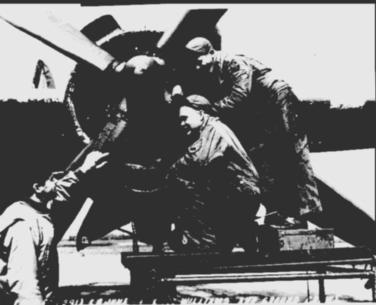






Wartime Airfields
rjkdesign
Wartime Airfields
rjkdesign


Wartime Airfields
Wartime Airfields

USAAF Matching Green- The Human Element

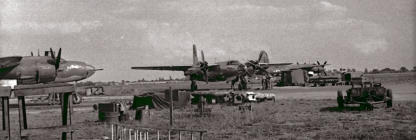
B-26 Martin Marauders of the 391st Bomb Group (Medium) on their
hardstands at Matching airfield.
Photo courtesy of Dane Donato.
Tech Sergeant Ralph Hobbs-391st Bomb
Group.
Ryan
Hobb's
Grandfather
was
a
Tech
Sergeant,
and
flew
with
the
391st
BG
(M),
as
a
Flight
Engineer/Gunner,
until
late
Spring, 1944.
He
then
served
as
a
Crew
Chief
when,
finally,
there
were
enough
Flight
Engineers
available to crew the aircraft.
Below
is
a
series
of
Photographs
taken
at
Matching,
while
he
was
stationed
there
during the Second World War.60 years on.
Martin
Marauder
B-26
"Ladybelle"
on
its
hardstand,
at
Matching,
with
Ralph
Hobbs.
Note
the
"T2"
type
aircraft
hangar
that
appears
under
construction
in
the
background.
This
is
the
No
2
Hangar
that
was
on
the
South
Eastern
side
of
the
airfield
near
Stock
Hall
and
was
never
actually finished.
Ryan Hobbs is Ralphs Grandson. He visited Matching airfield in 2004
and is pictured standing, more or less on the same spot
as Ralph was albeit sixty years on.
Ralph Hobbs (third from left -back row) with other crew chiefs in front of
the crew chiefs hut on Matching. These huts were made from discarded
bomb packing cases (see the door!) and provided welcome shelter
whilst out on the airfields dispersals.
'Mission 47" By Wally Humphrey, 391st BG
The
pre-dinner
crowd
at
the
Officers
Club
was
going
through
its
daily
routine
of
getting
a
few
drinks
put
away
before
undertaking
the
usual
monotonous
army
mess;
I
say
monotonous
because
although
the
menu
may
vary,
eating
army
chow
is
a
habit
and
not
a
pleasure.There
was
the
usual
line
at
the
bar,
the
Ping-pong
tables
were
in
full
play,
someone
was
banging
out
a
tune
on
the
piano
in
competition
with
the
radio
and
about
various
tables
were
gathered
the
different
Squadrons
of
the
Group;
just
talking
shop
or
deep
in
idle
gossip,
with
an
array
of
half-
filled
beer
bottles
and
glasses
in
hand
or
on
the
table.
At
precisely
five
minutes
to
six,
just
five
minutes
before
the
mess
hall
would
open,
the
telephone
rang,
the
bartender
answered
and
called
for
Capt.
Cunningham,
one
of
the
Group
intelligence
Officers;
seconds
later
he
called
for
attention
and
announced
that
all
alerted
crews
were
to
report
to
briefing
room
immediately,
without
eating.Well,
like
the
Armys
universal
"hurry
up
and
wait,"
it
was
after
1900
before
briefing
started,
and
quite
naturally
everyone
did
his
share
of
bitching
at
the
ways
of
the
Group and Bomber Command.
Our
target
was
behind
the
enemy
lines
at
a
troop
concentration
point,
and
the
route
in
and
out
was
shown
on
the
Velopticon,
which
projects
pictures
and
maps
on
a
screen;
soft
whistles
and
moans
came
from
crew
members,
it
definitely
was
a
hot
spot.
Engines
would
be
starting
at
2021,
the
second
box
off
first,
join
up
would
be
over
the
field
at
2055,
with
all
planes
in
formation
and
climbing
on
course.
Briefing
over,
everyone
gathered
his
parachute,
"Mae
West",
steel
helmet,
spare
chunks
of
armor
plate,
and
headed
out
for
the
six-by-six
trucks
that
distribute the crews to the various hardstands.
We
were
scheduled
to
fly
"Pinks
Lady"
out
on
her
81st
Combat
mission
without
an
abortion;
seems
our
ship
had
developed
mag
drop
and
needed
a
new
set
of
plugs
in
the
engine.
A
tribute
here
to
the
ground
crews
is
justified,
for
during
our
five
months
of
overseas
operation
we
have
had
only
two
single-engine
take-offs;
both
of
resulted
in
crash
landings.
But
here
too
the
B-26
comes
in
for
its
share
of
glory,
for
in
none
of
the
crash
landings
so
far
have
we
lost
a
single
crew
member;
some
have
been
injured
true,
but
they
all
have
managed
to
live
for
another
day.
2021,
and
engines
come
to
life
all
over
the
field,
to
be
warmed
up
and
flight
checked.
Ten
minutes
later
they
taxi
out,
each
one
falling
into
his
place
on
the
perimeter,
till
they
are
lined
up
one
being
behind
the
other
on
both
sides
of
runway
21
(210
degree
takeoff);
there
they
sway
softly
on
tricycle
landing
gears,
not
unlike
some
animated
creation
of
man
eager
to
spring
into
life
and
the
calling
vastness
of
the
sky above.
At
2036
the
lead
ships
engines
roar
and
the
plane
leaps
forward,
gathering
speed
with
every
passing
yard
of
the
runway.
About
300
yards
go
by
before
the
pilot
pulls
the
nose
wheel
off
at
90
or
more
miles
per
hour,
slowly
the
airs
speed
indicator
climbs
towards
150,
the
plane
becomes
airborne;
seconds
later
the
end
of
the
runway
flashes
by
and
four
feet
in
the
air
the
copilot
lifts
the
wheels
and
divides
his
attention
between the flight instruments and the view on his side of the cockpit.
However,
England
is
showing
some
of
its
best
weather
and
visibility
is
unlimited
in
all
directions,
although
some
clouds
are
building
in
the
West
and
to
the
South,
well,
that
would
be
right
for
the
weather
man
had
briefed
us
for
clouds
over
the
channel
and
from
.4
to
.6
tenth
Cumulus
over
the
target
with
bases
at
4,000
and
tops
at
9,000.Westward
we
climb
on
course,
directly
into
the
setting
sun.
Jeff
had
borrowed
my
sun
glasses
in
anticipation
of
its
glare;
you
see,
the
copilot
is
a
sort
of
second
brain
trust,
his
glasses
and
cigarettes
must
always
be
on
hand
and
never,
never
must
he
forget
matches
or
a
lighter.
The
formation
comes
within
view
of
the
moors
and
hills
of
South
Central
England,
then
swings
southward
still
climbing
in
a
slow
easy
angle
or
rate
of
climb;
too
rapid
a
rate
will
cause
the
slower
ships
to
pull
high
manifold
pressure
and
r.p.m.,
thereby
burning
a
terrific
amount
of
gas.
Some
8,000
below
the
English
coast
passes
underneath,
clouds
have
now
built
up
and
the
outside
temperature
is
zero
degrees
Centigrade;
so
that
we
dodge
and
weave
about
them
as
much
as
possible,
still
we
collect some ice, and the pitot-heaters have to be turned on.
Out
over
mid-channel
the
weather
truly
dominates
the
scene,
showers
are
over
on
the
left
of
us,
and
no
less
than
three
separate
layers
of
clouds
fill
the
sky;
some
being
flat
rain-filled
Nimbo-Cumulus
and
others
towering
snow-white
Cumulus,
that
catch
the
rays
of
the
setting
sun
in
breathless
beauty.
Then
true
to
Lt.
Henrys
prediction
the
clouds
began
to
break
out
of
their
solid
effect
and
between
the
openings
we
catch
glimpses
of
the
murky
Seine
Bay
and
the
distant
coast
of
the
Cherbourg
Peninsula;
darkness
is
setting
in
pretty
fast
now
and
the
closer
we
approach land the clearer becomes the details of battle.
A
dull
red
flash
leaps
from
one
of
the
hundreds
of
plots
on
the
bay
below,
then
a
similar
flash
from
a
companion
ship.
Hell,
it
must
be
warships
or
cruisers
giving
their
supporting
fire
to
the
armies
on
land;
sure
enough,
see
those
clustered
pin-point
flashes
inland,
just
like
the
winking
of
distant
stars.
Look
at
the
cloud
of
flak
over
Caen
and
St.
Lo,
hundreds
of
bursts
and
just
dark
enough
to
see
their
orange
bursts;
those
Lancasters
and
Halifaxes
that
were
ahead
of
us
coming
across
the
channel
must
be
catching
it,
gad,
I
hope
the
dive
bombers
and
fighters
are
spoiling
the
tracking
of
those
Jerry
Ack-Ack
gunners.
Weve
lost
track
of
the
first
box
coming
through
the
cloudy
channel,
and
our
box
does
a
360-degree
turn
to
gain
more
altitude
and
make
landfall
at
the
correct
place.
Damn,
its
dark,
how
in
the
world
are
we
going
to
find
our
target
in
this
mess?
Now
we
can
see
the
irregular
line
of
artillery
fire,
coming
from
both
sides
at
that,
sure
am
glad
Im
in
the
Air
Corps.
Oh! Oh! Look at the flak low and to our right.
Guess
they
are
trying
to
scare
us
away
from
some
vital
target;
no,
they
are
shooting
at
a
box
of
Marauders
lower
than
us
and
heading
towards
the
channel
and
safety.
They
sweep
under
us
at
a
terrific
speed.
Look
at
the
concentrated
pattern
of
their
bursting
bombs
just
made;
something
down
there
no
longer
exists.
"Bomb-bays
open"
comes
over
the
interphone.
Must
be
we
are
hitting
a
target
of
opportunity
due
to
darkness
spoiling
visibility
over
the
primary.
"Bombs
away,
bomb-bays
closed"
and
we
bank
off
the
target
in
a
steep
turn
and
take
evasive
action
clear
to
the
coast.
Well,
that
was
an
easy
one,
very
little
flak
and
we
dropped
on
the
first
run;
and
with
good
results.
We
plow
back
towards
our
base
letting
down
gradually
all
the
way.
The
B-26
can
really
travel with the nose slightly down and bombs away.
Twilight
has
given
way
to
almost
complete
darkness
and
at
mid-channel
we
turn
on
our
navigational
lights,
feeling
certain
that
we
are
safe
from
enemy
fighters.
Back
over
the
field
we
peel
off
by
flights
and
land,
each
ship
coming
in
at
about
20
second
intervals,
the
same
as
for
takeoff.
Safely
down
we
taxi
to
our
hardstands,
where
the
crew
chiefs
hand-
signal
us
to
our
parking
position,
then
we
unload
and
wait
for
the
trucks
to
carry
us
into
the
crew
room
for
debriefing;
meanwhile
watching
planes
landing
on
the
runway
nearby,
gad,
they
come
in
at
a
terrific
speed,
so
it
seems
on
the
ground.Debriefed,
we
get
our
two
shots
of
Scotch
and
head
for
the
mess
hall,
plenty
hungry
and
most
of
us
well
tired
out.
Chow
for
a
change
goes
down
very
well
and
a
quiet
comfortable
feeling
settles
over
you;
but
the
usual
second
cigarette
and
second
cup
of
coffee
is
dismissed,
for
we
are
alerted
tomorrow
and
the
best
we
can
expect
four
hours
sleep.
Back
to
our
huts,
some
take
time
out
to
wash
up,
while
others
hit
the
sack
as
soon
as
they
can
strip
off
their
clothes;
but
little
matter,
lights
are
soon
turned
off
and
heavy
breathing
fills
the
room.
Another
mission
completed
and
a
step
closer
to
home.
Note:
Written
July
8th
1944
regarding
a
mission
flown
on
the
evening
of
July
7
1944.
It
was
Wally
Humphrey's
47th
mission.
Wally
Humphrey
was
with
the
573rd
Squadron.
The
mission
in
this
story
was
the
marshalling
yards
at
Lisieux,
France.
Eight,
500-lb.
bombs,
were
dropped on the target from his aircraft.
The loss of Short Stirling PW 391.
© Kathleen Howes, who writes of her Fathers service life and the
ultimate sacrifice he made while flying from RAF Matching.
My
father
"Pops"
W.
John
Howes,
volunteered
for
the
RAF
in
July
1940
at
the
age
of
18.
Following
his
training
in
Marlow
and
a
lot
of
square
bashing
he
was
selected
for
Arnold
Scheme
pilot
training
in
October
1941.
He
arrived
at
Moncton,
New
Brunswick,
Canada
in
the
winter
of
1941
crossing
the
Atlantic
on
the
'Pasteur'.
He
gained
both
RAF
and
American
pilots
wings
in
August
1942
and
did
not
return
to
Britain
until
July
1943
when
he
was
already
trained
as
an
Instructor
and
had
been
training
USAAF
pilots.
He
returned
as
Flying
Officer
and
married
his
fiancé
Anne,
one
week
after
arriving
back
in
the
UK,
they
had
been
apart for 20 long months. Here are details of his service life:
UK Service
RAF Regiment August and September 1943 at RAF Sidmouth
29/9/43 at No 6 ( Pilots) Advanced Flying Unit 23 Group; Little
Rissington, near Cheltenham in Gloucester.
7/3/44-28/7/44 DGp/FTC/4462/44/4042 OTU Ashbourne
28/7/44 38GP/1209/44 ORTU Hampstead Norris Operational and
refresher Training Units, Oxfordshire.(Harwell Sattelite)
9/9/44 ORTU Operations Nickel raid Samson harbour Guernsey.
DGp/FC/9255/44 23 HGCU October 44 Seighford, Shropshire Glider
Conversion Unit Glider Conversion Units at Peplow (Sat)
Crew Taffy, Ken, Fred, Mac + Brand new Stirling aircraft
December 44 Posted to Tilstock 38 Gp 2379/44.
Now 'Pops’ is Senior Pilot. A promise from Sq/Leader Watts that he will
get promotion to Fl/Commander after 1400 hours flying. He takes over
from Fl/Com George Sharpe.
His Daughter Kathleen was born on the 19/02/45, John is on 10 days
leave from 19-28th February so the crew miss postings to the new
Squadron.
03/03/45 FINAL Posting 38Gp/675/40 ORTU Matching Essex. 24/03/45
Operation "Varsity " Glider tug to eastern Rhine Crossing. (Further
details available)
Fatal Accident 29/03/45 Mark IV Stirling PW 391 Official version Non
operational flight .
29/03 /45 Flying Accident 14.55 hours Thorney, Northants.
Crew (Pops) Fl/Lt W John Howes
Mac Fl/Sgt R.H.MacAlpine
Taffy Fl/Sgt F .W Rees
Fred Fl/Sgt. F.C Aldersley,
P/O Ken R Inger, Sgt Ken Slee, Cpl J Hardy passenger.
They
were
on
a
check
flight
when
a
Miles
Master
Piloted
by
Cpl
(Free
French,)
Phillippe
de
Bienkkewicz
out
of
Peterborough,
collided
with
the
Stirling
cutting
off
the
tail.
Both
planes
burst
into
flames
and
crashed,
all
of
the
crew
in
both
aircraft
were
killed.
The
Place
of
death
is
recorded
as
Whittelsey.
Court
of
Inquiry
report
not
available.
John
had
completed
1466 hours flying. "
Another version of the crash is as follows,
"The
crew
&
Aircraft
are
reported
to
have
been
dropping
supplies
to
troops
on
the
Eastern
Rhine,
the
radio
malfunctioned
and
they
returned
to
base
for
repairs.
Following
repair
a
test
flight
was
carried
out
to
check
out
the
radio
over
Peterborough.
The
Stirling
was
returning
to
base
when
a
solo
trainer
aircraft
flew
out
of
a
cloud
and
crashed
into
the
Stirling,
killing
the
crew
of
seven
in
the
Stirling
and
the
solo
Pilot
of
the
Magister Cpl.R.de Bienkiewicz”.
The Crew:
Rees Frederick William
Flight Sergeant 1585283 RAFVR
age 33
1945-03-29 United Kingdom
Radipole (St. Ann) Churchyard Extension, East part.
Son Of David Thomas Rees And Florence Rees; Husband Of Edna
Pearl Rees, Of Weymouth.
Aldersley Frederick Charles
Warrant Officer 1385448 RAFVR
age 23
1945-03-29 United Kingdom
New Southgate Cemetery, Kerb Wall. Sec. A.H. Grave 279.
Inger Kenneth Rhodes
Flying Officer 153746 RAFVR
age 21
1945-03-29 United Kingdom
Wallasey (Rake Lane) Cemetery, Sec. 16.G. Grave 646.
Son Of Albert Rhodes Inger And Flora Inger, Of Wallasey.
Slee Kenneth
Sergeant 2205180
RAFVR age 19
1945-03-29 United Kingdom
Harrogate (Stonefall) Cemetery, Sec. 8E. Grave 155.
Son Of John Harold Omar Slee And Mary Slee, Of Harrogate.
Howes Walter John
Flight Lieutenant 127241 RAFVR
age 22
1945-03-29 United Kingdom
Lampeter (St. Peter) Churchyard, North of church.
Son Of Harry And Bessie Howes Husband Of Ann Kathleen Howes, Of
Lampeter.
McAlpine Robert Henry Flight Sergeant 2221305
RAFVR age 37
1945-03-29 United Kingdom
Peterborough (Eastfield) Cemetery, Div. 4, Block 16, Cons. Grave 6372.
Son Of John And Margaret Jane McAlpine.
Hardy John Corporal
567646 RAF
age ? (Passenger)
1945-03-29 United Kingdom
Peterborough (Eastfield) Cemetery, Div. 4, Block 16, Cons. Grave 6370.
From Bombers to Bee Orchids, Matching
airfield © by Paul Hewitt.
Matching
Airfield
is
one
of
my
favourite
sites
in
the
District.
There
can
be
no
prettier
sight
than
in
mid
June
when
the
100s
of
Common
Spotted
Orchids
and
Oxeye
Daisy
are
in
flower.
Countrycare
has
been
involved
with
the
site
since
1993
and
I
thought
it
would
be
interesting
to
set
out
the
chequered
history
as
I
understand
it.
I
apologise
in
advance
for
any
inaccuracies
and
I
would
very
much
welcome
any
comments
people
may have or any more information about this wonderful site.
I
start
the
story
on
the
20th
August
1942,
when
this
peaceful
corner
of
the
District
would
be
change
forever.
For
it
was
on
this
day
nearly
60
years
ago
to
the
day,
that
the
834th
Engineer
Aviation
Battalion
began
creating
a
bomber
airfield
on
farmland
and
woodland
to
the
east
of
Matching
Green.
Complete
with
runways,
access
tracks,
hangars,
a
hospital
and
350
ancillary
buildings,
enough
concrete
was
laid
at
Matching to create a 45-mile long dual carriageway!
The
initial
clearance
works
for
the
airfield
were
destructive.
Pottins
Farm
and
the
Kicking
Dickey
Pub
were
demolished
as
was
94
acres
of
Brickles
Wood,
an
area
of
ancient
woodland
that
was
cleared
to
make
way for access tracks and the bomb dump.
The
airfield
took
14
months
to
complete
and
the
records
show
it
involved
a
staggering
1.5
million
man-hours.
By
December
1943,
4
squadrons
of
the
391st
Bombardment
Group,
flying
B-26
Marauders
arrived
at
Matching
having
flown
10,000
miles
around
the
world
from
Kentucky,
USA.
By
the
beginning
of
February
1944,
the
391st
was
operational.
The
main
thrust
their
operations
were
the
weakening
of
enemy
defences
prior
to
the
D-Day
landings.
Their
targets
concentrated
on
transport
and
communications
links
as
well
as
coastal
defences,
submarine pens and rocket sites.
In
October
1944,
after
only
9
months,
the
391st
left
Matching
to
support
the
invasion
force
in
France.
Here
their
operations
continued
until
October
1945,
by
which
time
the
4
squadrons
had
flown
a
total
over
10,000
sorties.
As
in
all
wars
there
was
a
human
cost.
Some
219
airmen
were
killed
or
missing
in
action
and
61
were
wounded.
A
total
of
43 planes were lost.
After
the
war,
the
majority
of
the
land
was
reverted
to
back
to
farmland.
Much
given
back
to
the
Rowe
family
who
still
farm
the
land
today.
However,
many
of
the
old
buildings
and
track
ways
remained
including
the old control tower.
In
the
early
1980s
many
of
these
old
building
were
being
used
for
storage
and
became
the
subject
of
2
public
enquiries
in
1981
and
1982
regarding
the
sites
future
use.
The
decision
of
the
Secretary
of
State
was
that
the
site
should
be
cleared
of
all
buildings.
By
1986,
much
of
this
work
had
been
undertaken.
The
large
aircraft
hanger
(presumably
lovingly
dismantled
piece
by
piece)
was
then
rebuilt
at
North
Weald
Airfield.
Today
only
a
few
buildings
remain
around
Rookwood
Hall
and
the
old
control
tower
that
still
stands
looking
out
over
the
former
runway
that is now arable fields.
Once
the
site
had
been
cleared,
it
soon
became
obvious
that
the
crushed
concrete
had
provided
ideal
lime
rich
conditions
for
the
colonisation
of
many
unusual
and
uncommon
wildflowers.
It
may
well
have
been
that
these
flowers
existed
before
the
airfield
and
had
hung
on
in
undisturbed
areas
ready
to
recolonise?
In
1987,
the
Abbess
&
White
Roding
Conservation
Society
contacted
the
then
Essex
Naturalist
Trust
and
surveys
of
the
site
were
subsequently
undertaken.
In
1991
recognition
of
the
sites
nature
conservation
value
was
acknowledged
with the designation of the site as a County Wildlife Site.
By
1993,
it
was
becoming
clear
that
the
once
clear
area
was
slowly
being
encroached
by
scrub
and
Countrycare
was
asked
to
step
in
by
the
Abbess
&
White
Roding
Conservation
Society.
By
the
spring
of
1994,
Countrycare
had
managed
to
track
down
the
landowner,
met
with
him
and
obtained
permission
to
undertake
conservation
work
on
the
site.
The
first
conservation
projects
began
in
the
September
and
October
1994
and
a
management
plan
was
subsequently
written
in
1996.
Since
that
time
Countrycare
has
organised
a
regular
programme
of
scrub
bashing
and
hay
cutting
tasks
that
have
been
vital
to
maintain
the
open
grassy areas in which orchids and other wildflowers thrive.
A
survey
by
Annette
Ford
in
the
summer
of
1999
recorded
over
160
species
of
trees,
grasses
and
wild
flowers
and
included
in
the
plant
list
were
3
different
types
of
Orchid.
These
were
the
Common
Spotted
and
Bee
Orchids
that
exists
in
their
100s
and
a
small
colony
of
Pyramidal
Orchids
that
has
been
slowly
increasing
over
recent
years.
Other
notable
wildflowers
included
Wild
Basil,
Red
Bartsia
and
Common
Restharrow.
It seems to me that this special wildlife sites exists as a fitting tribute to
all the young Americans who fought and died from that airbase all those
years ago. With the continued support of our volunteers we can
hopefully continue to look after this unique site.

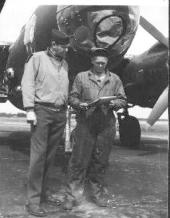
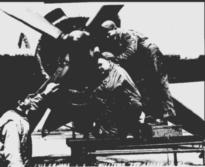
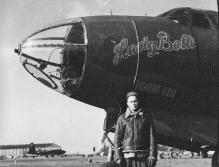


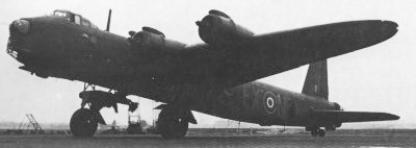


rjkdesign













